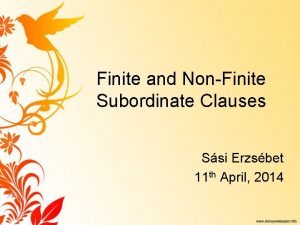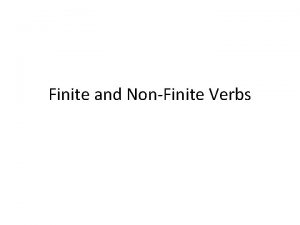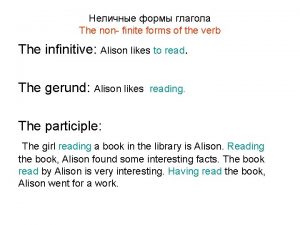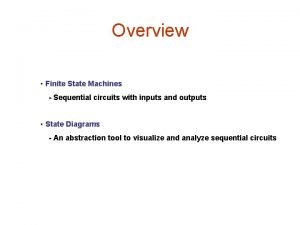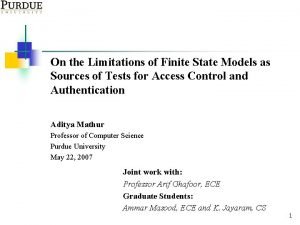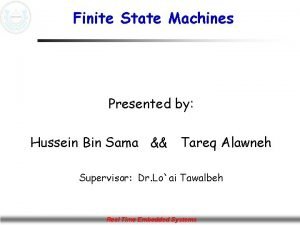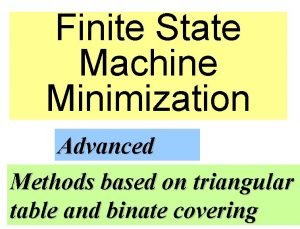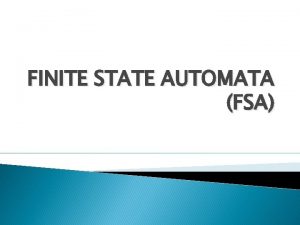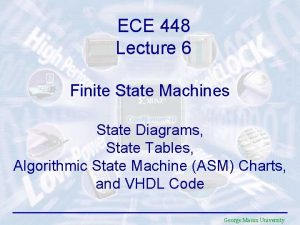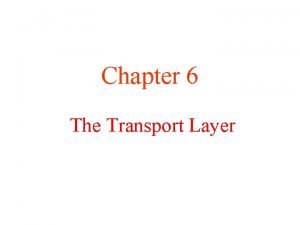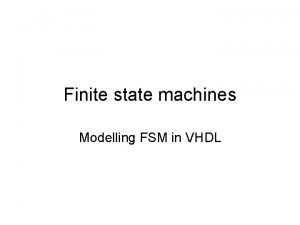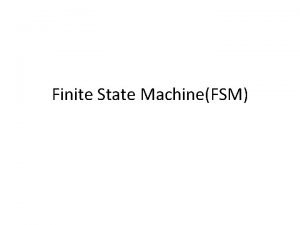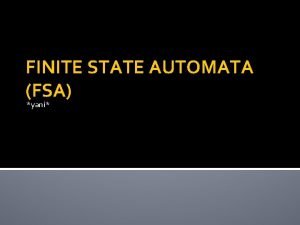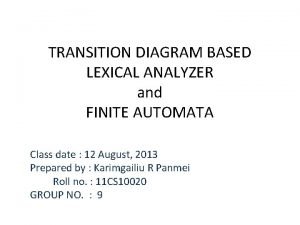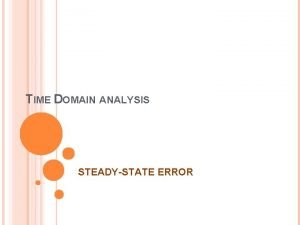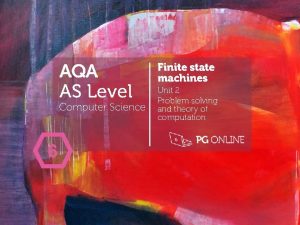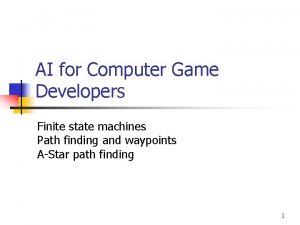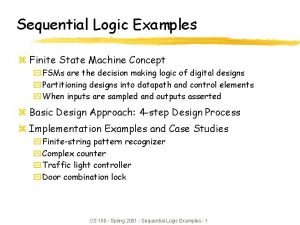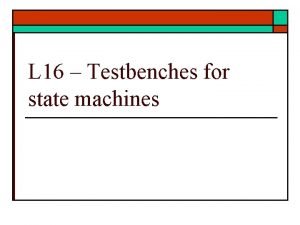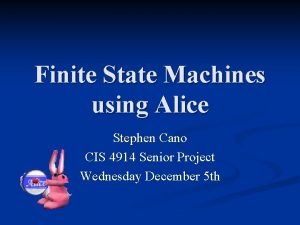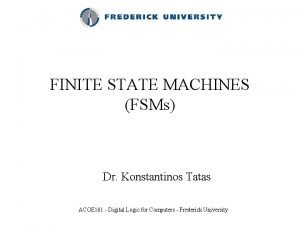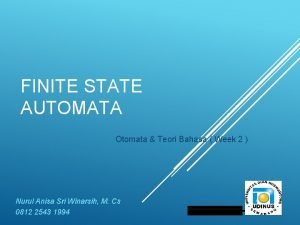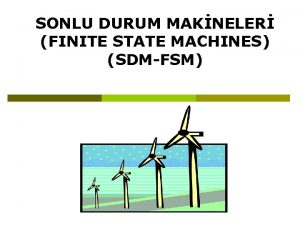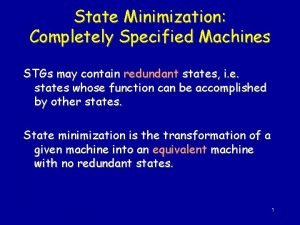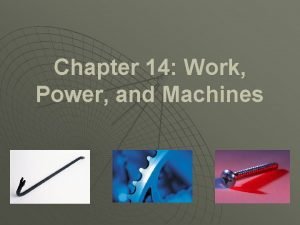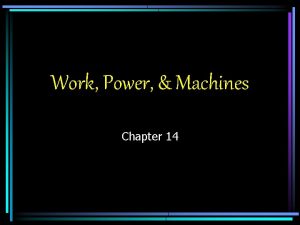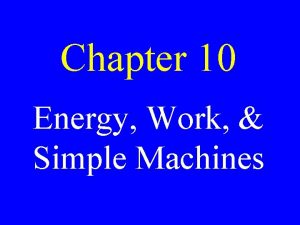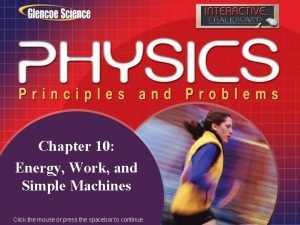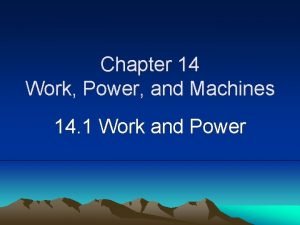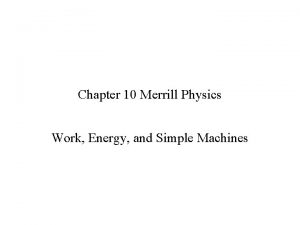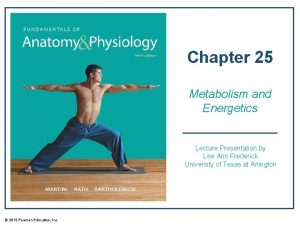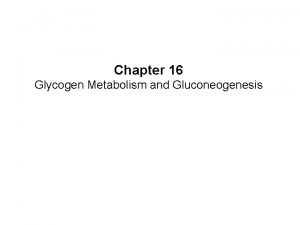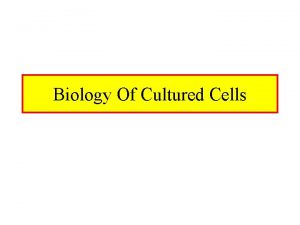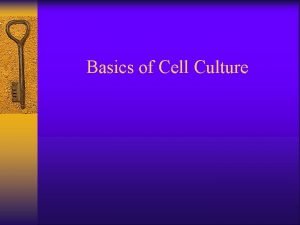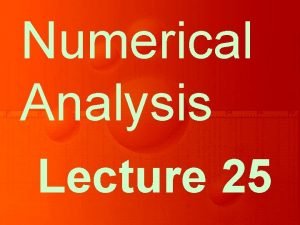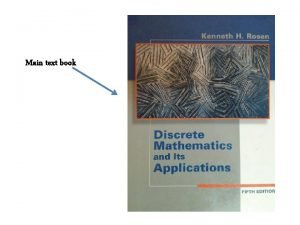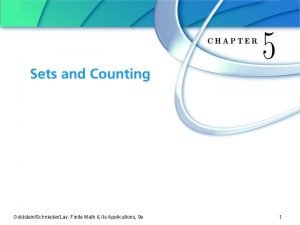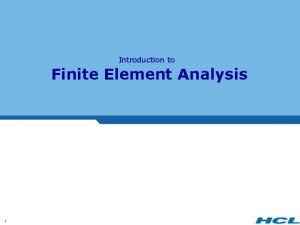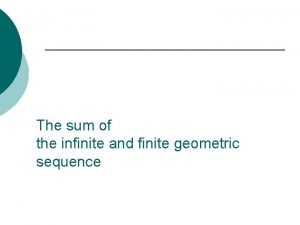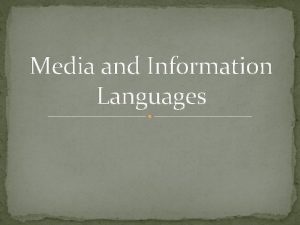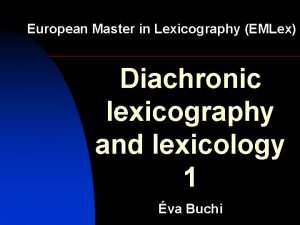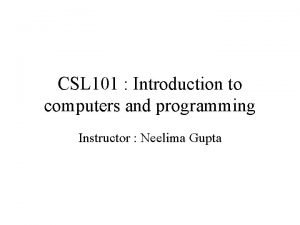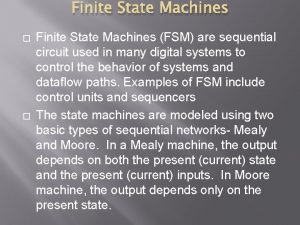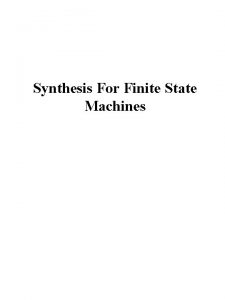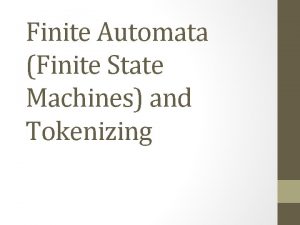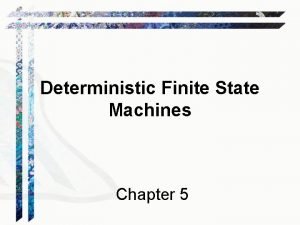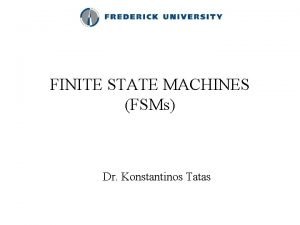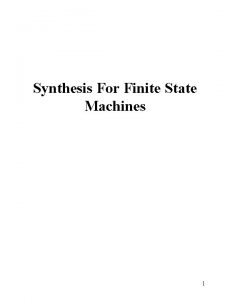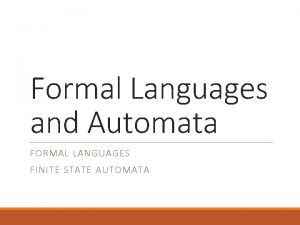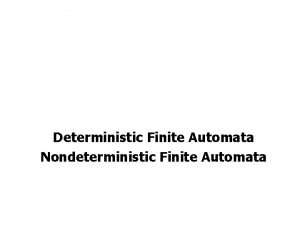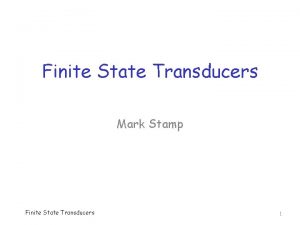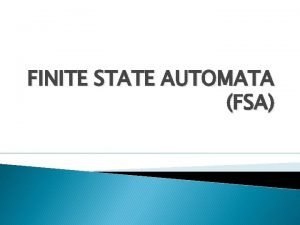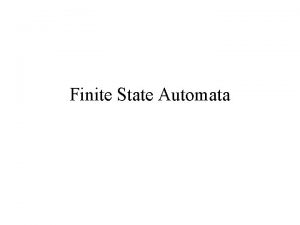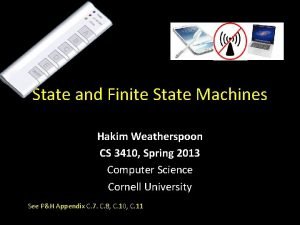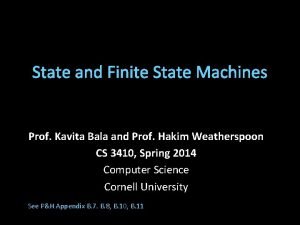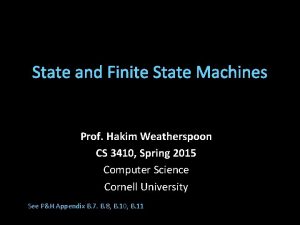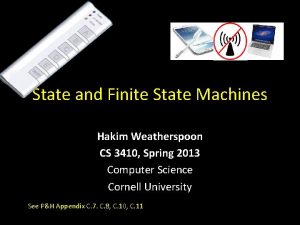Finite State Machines Chapter 5 Languages and Machines





































































- Slides: 69

Finite State Machines Chapter 5

Languages and Machines

Regular Languages L Regular Expression Regular Language Accepts Finite State Machine

Definition of a DFSM M = (K, , , s, A), where: K is a finite set of states is an alphabet s K is the initial state A K is the set of accepting states, and is the transition function from (K ) to K

Accepting by a DFSM Informally, M accepts a string w iff M ends up in some element of A (an accept state) when it has finished reading w. The language accepted by M, denoted L(M), is the set of all strings accepted by M.

Configurations of DFSMs A configuration of a DFSM M is an element of: K * It captures the two things that can make a difference to M’s future behavior: • its current state • the input that is still left to read. The initial configuration of a DFSM M, on input w, is: (s. M, w)

The Yields Relations The yields-in-one-step relation |-M: (q, w) |-M (q', w') iff • w = a w' for some symbol a , and • (q, a) = q' |-M * is the reflexive, transitive closure of |-M.

Computations Using FSMs A computation by M is a finite sequence of configurations C 0, C 1, …, Cn for some n 0 such that: • C 0 is an initial configuration, • Cn is of the form (q, ), for some state q KM, • C 0 |-M C 1 |-M C 2 |-M … |-M Cn.

Accepting and Rejecting A DFSM M accepts a string w iff: (s, w) |-M * (q, ), for some q A. A DFSM M rejects a string w iff: (s, w) |-M* (q, ), for some q AM. The language accepted by M, denoted L(M), is the set of all strings accepted by M. Theorem: Every DFSM M, on input s, halts in |s| steps.

An Example Computation An FSM to accept odd integers: even odd even q 0 q 1 odd On input 235, the configurations are: (q 0, 235) |-M |-M (q 0, 35) Thus (q 0, 235) |-M* (q 1, )

Regular Languages A language is regular iff it is accepted by some FSM.

A Very Simple Example L = {w {a, b}* : every a is immediately followed by a b}.

A Very Simple Example L = {w {a, b}* : every a is immediately followed by a b}.

Parity Checking L = {w {0, 1}* : w has odd parity}.

Parity Checking L = {w {0, 1}* : w has odd parity}.

No More Than One b L = {w {a, b}* : every a region in w is of even length}.

No More Than One b L = {w {a, b}* : w has no more than 1 b}.

Checking Consecutive Characters L = {w {a, b}* : no two consecutive characters are the same}.

Checking Consecutive Characters L = {w {a, b}* : no two consecutive characters are the same}. Error in Book, p. 61, d should not be an accept state.

Dead States L= {w {a, b}* : every a region in w is of even length}

Dead States L= {w {a, b}* : every a region in w is of even length}

Dead States L= {w {a, b}* : every b in w is surrounded by a’s}

The Language of Floating Point Numbers is Regular Example strings: +3. 0, 0. 3 E 1, 0. 3 E+1, -3 E 8 The language is accepted by the DFSM:

Programming FSMs Cluster strings that share a “future”. Let L = {w {a, b}* : w contains an even number of a’s and an odd number of b’s}

Even a’s Odd b’s

Vowels in Alphabetical Order L = {w {a - z}* : all five vowels, a, e, i, o, and u, occur in w in alphabetical order}.

Vowels in Alphabetical Order L = {w {a - z}* : all five vowels, a, e, i, o, and u, occur in w in alphabetical order}.

Programming FSMs L = {w {a, b}* : w does not contain the substring aab}.

Programming FSMs L = {w {a, b}* : w does not contain the substring aab}. Start with a machine for L: How must it be changed?

A Building Security System L = {event sequences such that the alarm should sound}

The Missing Letter Language Let = {a, b, c, d}. Let LMissing = {w : there is a symbol ai not appearing in w}. Try to make a DFSM for LMissing:

Definition of an NDFSM M = (K, , , s, A), where: K is a finite set of states is an alphabet s K is the initial state A K is the set of accepting states, and is the transition relation. It is a finite subset of (K ( { })) K

Accepting by an NDFSM M accepts a string w iff there exists some path along which w drives M to some element of A. The language accepted by M, denoted L(M), is the set of all strings accepted by M.

Sources of Nondeterminism

Analyzing Nondeterministic FSMs Two approaches: • Explore a search tree: • Follow all paths in parallel

Optional Substrings L = {w {a, b}* : w is made up of an optional a followed by aa followed by zero or more b’s}.

Multiple Sublanguages L = {w {a, b}* : w = aba or |w| is even}.

The Missing Letter Language Let = {a, b, c, d}. Let LMissing = {w : there is a symbol ai not appearing in w}

The Missing Letter Language

Pattern Matching L = {w {a, b, c}* : x, y {a, b, c}* (w = x abcabb y)}. A DFSM:

Pattern Matching L = {w {a, b, c}* : x, y {a, b, c}* (w = x abcabb y)}. An NDFSM:

Pattern Matching with NDFSMs L = {w {a, b}* : x, y {a, b}* : w = x aabbb y or w = x abbab y }

Multiple Keywords L = {w {a, b}* : x, y {a, b}* ((w = x abbaa y) (w = x baba y))}.

Checking from the End L = {w {a, b}* : the fourth to the last character is a}

Checking from the End L = {w {a, b}* : the fourth to the last character is a}

Another Pattern Matching Example L = {w {0, 1}* : w is the binary encoding of a positive integer that is divisible by 16 or is odd}

Another NDFSM L 1= {w {a, b}*: aa occurs in w} L 2= {x {a, b}*: bb occurs in x} L 3= {y : L 1 or L 2 } M 1 = M 2 = M 3 =

A “Real” Example

Analyzing Nondeterministic FSMs Does this FSM accept: baaba Remember: we just have to find one accepting path.

Analyzing Nondeterministic FSMs Two approaches: • Explore a search tree: • Follow all paths in parallel

Another Nondeterministic Example b* (b(a c)c b(a b) (c ))* b

Dealing with Transitions eps(q) = {p K : (q, w) |-*M (p, w)}. eps(q) is the closure of {q} under the relation {(p, r) : there is a transition (p, , r) }. How shall we compute eps(q)?

An Algorithm to Compute eps(q) eps(q: state) = result = {q}. While there exists some p result and some r result and some transition (p, , r) do: Insert r into result. Return result.

An Example of eps(q 0) = eps(q 1) = eps(q 2) = eps(q 3) =

Simulating a NDFSM ndfsmsimulate(M: NDFSM, w: string) = 1. current-state = eps(s). 2. While any input symbols in w remain to be read do: 1. c = get-next-symbol(w). 2. next-state = . 3. For each state q in current-state do: For each state p such that (q, c, p) do: next-state = next-state eps(p). 4. current-state = next-state. 3. If current-state contains any states in A, accept. Else reject.

Nondeterministic and Deterministic FSMs Clearly: {Languages accepted by a DFSM} {Languages accepted by a NDFSM} More interestingly: Theorem: For each NDFSM, there is an equivalent DFSM.

Nondeterministic and Deterministic FSMs Theorem: For each NDFSM, there is an equivalent DFSM. Proof: By construction: Given a NDFSM M = (K, , , s, A), we construct M' = (K', , ', s', A'), where K' = P(K) s' = eps(s) A' = {Q K : Q A } '(Q, a) = {eps(p): p K and (q, a, p) for some q Q}

An Algorithm for Constructing the Deterministic FSM 1. Compute the eps(q)’s. 2. Compute s' = eps(s). 3. Compute ‘. 4. Compute K' = a subset of P(K). 5. Compute A' = {Q K' : Q A }.

The Algorithm ndfsmtodfsm(M: NDFSM) = 1. For each state q in KM do: 1. 1 Compute eps(q). 2. s' = eps(s) 3. Compute ': 3. 1 active-states = {s'}. 3. 2 ' = . 3. 3 While there exists some element Q of active-states for which ' has not yet been computed do: For each character c in M do: new-state = . For each state q in Q do: For each state p such that (q, c, p) do: new-state = new-state eps(p). Add the transition (Q, c, new-state) to '. If new-state active-states then insert it. 4. K' = active-states. 5. A' = {Q K' : Q A }.

An Example

The Number of States May Grow Exponentially | | = n No. of states after 0 chars: No. of new states after 1 char: =1 =n No. of new states after 2 chars: = n(n-1)/2 No. of new states after 3 chars: = n(n-1)(n-2)/6 Total number of states after n chars: 2 n

Another Hard Example L = {w {a, b}* : the fourth to the last character is a}

If the Original FSM is Deterministic M 1. Compute the eps(q)s: 2. s' = eps(q 0) = 3. Compute ' ({q 0}, odd, {q 1}) ({q 1}, odd, {q 1}) 4. K' = {{q 0}, {q 1}} 5. A' = { {q 1} } ({q 0}, even, {q 0}) ({q 1}, even, {q 0}) M' = M

The Real Meaning of “Determinism” Let M = Is M deterministic? An FSM is deterministic, in the most general definition of determinism, if, for each input and state, there is at most one possible transition. • DFSMs are always deterministic. Why? • NDFSMs can be deterministic (even with -transitions and implicit dead states), but the formalism allows nondeterminism, in general. • Determinism implies uniquely defined machine behavior.

Deterministic FSMs as Algorithms L = {w {a, b}* : w contains no more than one b}:

Deterministic FSMs as Algorithms until accept or reject do: S: s = get-next-symbol if s = end-of-file then accept else if s = a then go to S else if s = b then go to T T: s = get-next-symbol if s = end-of-file then accept else if s = a then go to T else if s = b then reject end

Deterministic FSMs as Algorithms until accept or reject do: S: s = get-next-symbol if s = end-of-file then accept else if s = a then go to S else if s = b then go to T T: s = get-next-symbol if s = end-of-file then accept else if s = a then go to T else if s = b then reject end Length of Program: |K| (| | + 2) Time required to analyze string w: O(|w| | |) We have to write new code for every new FSM.

A Deterministic FSM Interpreter dfsmsimulate(M: DFSM, w: string) = 1. st = s. 2. Repeat 2. 1 c = get-next-symbol(w). 2. 2 If c end-of-file then 2. 2. 1 st = (st, c). until c = end-of-file. 3. If st A then accept else reject. Input: aabaa

Nondeterministic FSMs as Algorithms Real computers are deterministic, so we have three choices if we want to execute a NDFSM: 1. Convert the NDFSM to a deterministic one: • Conversion can take time and space 2|K|. • Time to analyze string w: O(|w|) 2. Simulate the behavior of the nondeterministic one by constructing sets of states "on the fly" during execution • No conversion cost • Time to analyze string w: O(|w| |K|2) 3. Do a depth-first search of all paths through the nondeterministic machine.
 Finite subordinate clauses
Finite subordinate clauses Finite verb
Finite verb Learning objectives for finite and non finite verbs
Learning objectives for finite and non finite verbs How to find finite and nonfinite verbs
How to find finite and nonfinite verbs Finite and non finite
Finite and non finite Maximum segment size
Maximum segment size Soal teori bahasa dan automata
Soal teori bahasa dan automata Finite state machine sequential circuits
Finite state machine sequential circuits Limitations of finite automata
Limitations of finite automata Finite state machine with datapath
Finite state machine with datapath Finite state machine minimization
Finite state machine minimization Finite automata dikelompokkan menjadi
Finite automata dikelompokkan menjadi Vhdl finite state machine
Vhdl finite state machine Traffic light finite state machine
Traffic light finite state machine Transport layer primitives
Transport layer primitives Types of fsm
Types of fsm Elevator finite state machine
Elevator finite state machine Fsa diagram
Fsa diagram Finite state machine vending machine example
Finite state machine vending machine example Finite state diagram generator
Finite state diagram generator Steady state error in control system
Steady state error in control system Finite state machine
Finite state machine Ospf finite state machine
Ospf finite state machine Finite state machine
Finite state machine Finite state machine game
Finite state machine game Fsm design examples
Fsm design examples Gambarkan graf transisi berdasarkan pendekatan mesin moore
Gambarkan graf transisi berdasarkan pendekatan mesin moore Contoh aturan produksi
Contoh aturan produksi Finite state machine vhdl testbench
Finite state machine vhdl testbench Cis4914
Cis4914 Finite state machine
Finite state machine Deterministic finite state automata
Deterministic finite state automata Gambarlah diagram transisi untuk nfa berikut
Gambarlah diagram transisi untuk nfa berikut Sequential state machine
Sequential state machine Languages in akwa ibom state
Languages in akwa ibom state Chapter 4 section 1 work and machines answer key
Chapter 4 section 1 work and machines answer key Incompletely specified state machines
Incompletely specified state machines State machines digital electronics
State machines digital electronics Chapter 14 work power and machines
Chapter 14 work power and machines Chapter 10 energy work and simple machines answer key
Chapter 10 energy work and simple machines answer key Chapter 14 work power and machines
Chapter 14 work power and machines Chapter 10 energy, work and simple machines answer key
Chapter 10 energy, work and simple machines answer key Energy work and simple machines chapter 10 answers
Energy work and simple machines chapter 10 answers Chapter 14 section 1 work and power
Chapter 14 section 1 work and power Chapter 10 work energy and machines
Chapter 10 work energy and machines Software implementation of state graph
Software implementation of state graph Absorptive state and postabsorptive state
Absorptive state and postabsorptive state Glycogen storage disease table
Glycogen storage disease table Zczc state graph
Zczc state graph 1^5+2^5+3^5+...+n^5 formula
1^5+2^5+3^5+...+n^5 formula Finite and continuous cell lines
Finite and continuous cell lines Finite and continuous cell lines
Finite and continuous cell lines Finite and continuous cell lines
Finite and continuous cell lines Interpolation
Interpolation Finite and infinite sets
Finite and infinite sets Finite fields in cryptography and network security
Finite fields in cryptography and network security Sets and counting finite math
Sets and counting finite math Difference between fea and fem
Difference between fea and fem Sum of infinite geometric series
Sum of infinite geometric series Real-time systems and programming languages
Real-time systems and programming languages Cs 421
Cs 421 Languages for life and work
Languages for life and work What is media and information languages
What is media and information languages Front end vs back end compiler
Front end vs back end compiler Latin and romance languages
Latin and romance languages Defence centre for languages and culture
Defence centre for languages and culture Difference between strongly and weakly typed languages
Difference between strongly and weakly typed languages List the primitives that specify a data mining task
List the primitives that specify a data mining task Media and information literacy performance task
Media and information literacy performance task Automata theory tutorial
Automata theory tutorial
